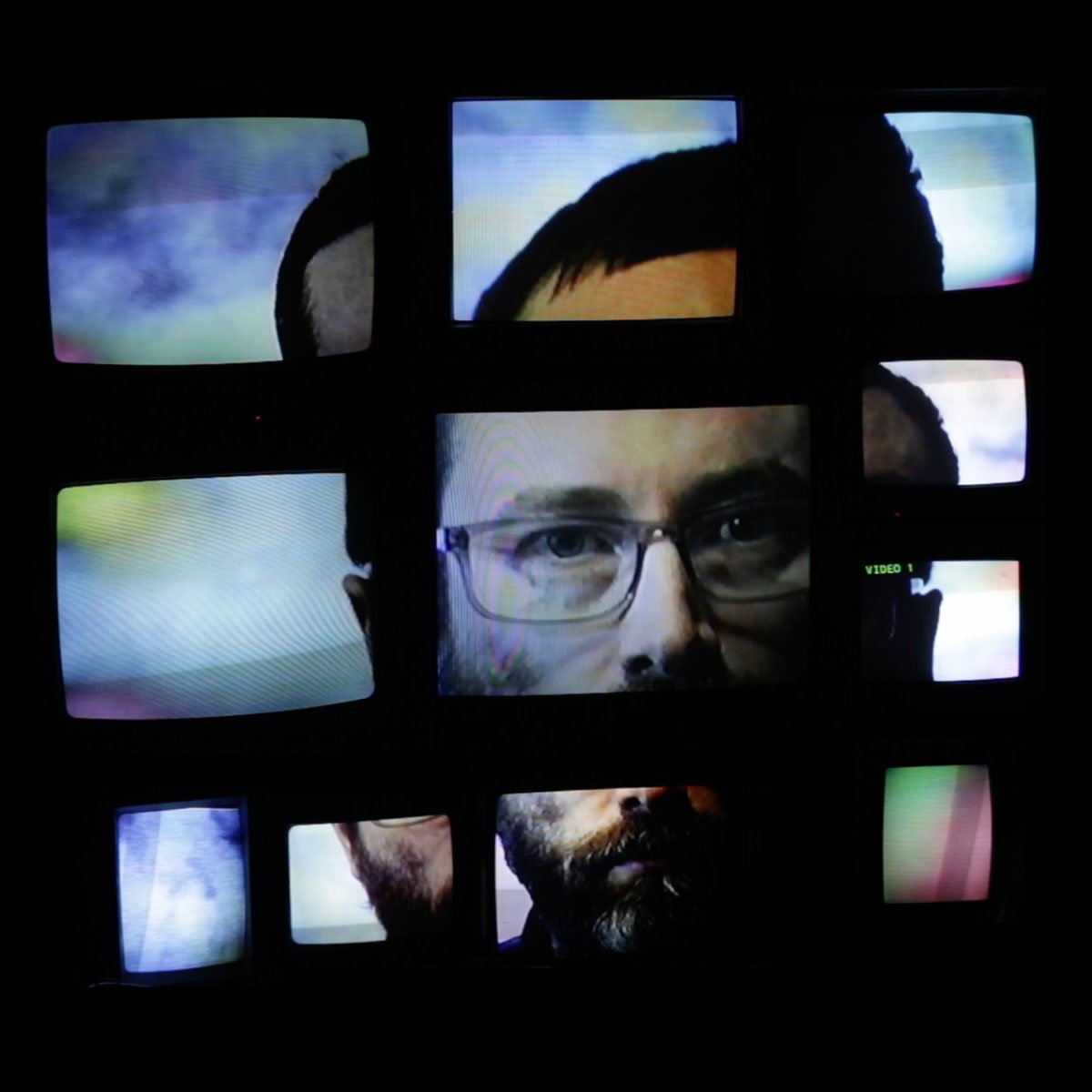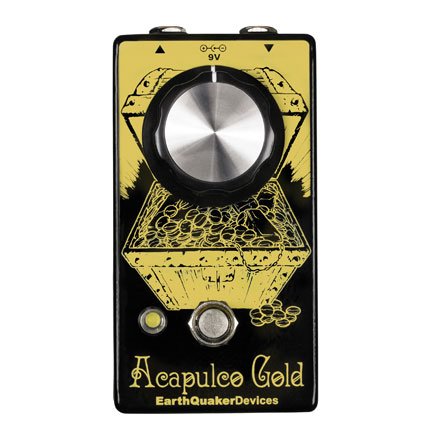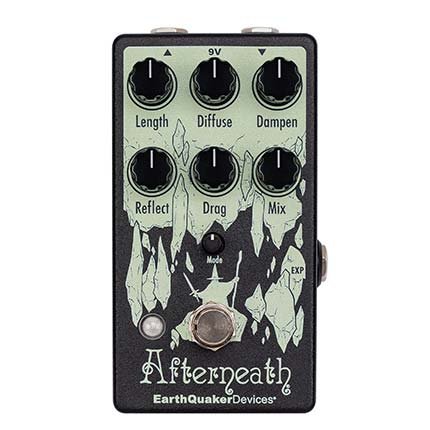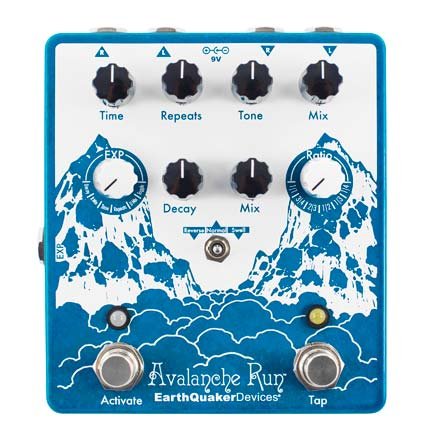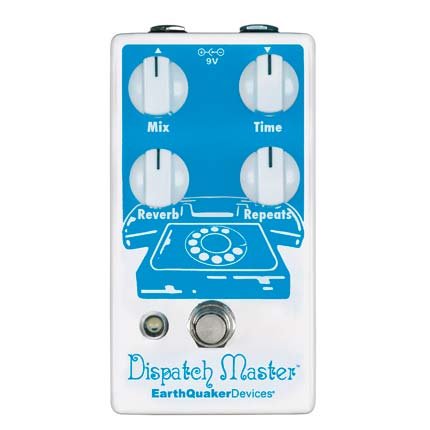Employee Pedalboards : Jeff France's Audio / Visual Spectacular
Jeff France
When we were all stuck at home for a year or so, I decided to make something in my basement that I probably would never have found the time for otherwise. This project consisted of a couple of elements. The first and most noticeable element was a wall of TVs I had collected from curb scores around my city. If I saw a TV lying on the curb, I would always stop and pick it up unless the guy that goes around and cuts the power cables off had gotten to it first. Anyway, each TV was fed video and audio from its own VCR, and I had 11 of them in the stack.
The second element was a live instrumental performance, using many different instruments to play along with the music made by the VCRs. I started with turntables, then drum machines and guitar, and turntables again in the second song, "Gemini." The third song, "Soloed-On Solitude," is just guitar, and the fourth song, "It's Just a Phase," is guitar and loop pedals, and then I move to drums and an MPC before closing by playing effects and a mixer to some random audio performed onto the VHS tapes.
Anyway, let's go over what is going on here, and maybe if you read long enough, I'll cover how I kept it all in time and did my composition. But I was asked to cover the guitar and pedalboard stuff first because while all of it is super nerdy, that stuff is probably the nerdiest. Let's do this.
How I organized the signal flow of the guitar:
The guitar I play during the piece goes into two pedalboards, some other random effects, and various signal flows. The first thing it goes into is my main pedalboard. That pedalboard starts with a Digitech Whammy 2. I use both outs of the Whammy to split the signal into separate wet and dry signals. The wet-out signal path is EQD Arrows → EQD Speaker Cranker → Empress Superdelay Vintage Modified → Mesa Boogie V Twin preamp pedal. I have another split at the V Twin as it has multiple outs. Those outs go to a guitar amp, a power amp, and a mixer/headphones. From there, I use the guitar amp out and the mixer/headphones out. The mixer out goes to input 2 of an Alesis IODock2 that runs into an iPad running AUM (Audio Unit Mixer is a great app for interfacing iPad music apps and hardware through an iPad compatible interface).
Now we need to back up to the Digitech Whammy 4 and follow the signal flow of the dry output. From the Whammy's dry output, the signal goes D'Addario tuner → Sonus G2M guitar to monophonic midi converter. Then we have another split going. The Sonus has a through out sent to input one of that Alexis IODock, and that input is set to the high impedance/instrument-in setting and then into another channel in AUM. That AUM channel runs the Roxsyn app, a polyphonic guitar synth app. The second part of the split is a midi cable that comes out of the Sonus G2M and goes to the midi din input on the IODock2, also going to a different channel in AUM, running Moog Audio's Model D app.
At this point, the three pathways I have covered merge and go out to the center channel of a Rane Empath mixer. The Rane Empath is a discontinued three-channel DJ mixer from the analog era of turntablism. These days, most people are using software to handle stuff like this, and the mixers you buy are designed to integrate with whatever app you are using, like Rekordbox or Serato. I wouldn't mind using a contemporary mixer, but I need at least three channels, and I need individual track pan controls, and they don't really make that anymore. Not sure why people don't pan stuff anymore, but the pan controls and the way the effects loop work on the Empath are pretty crucial.
Okay, so we have signal flow one into the Rane handled. This center channel only ever receives this signal. Now, I want to cover the previously mentioned effects loop because that is the final part of one of the guitar signal paths and the only signal path used during "Gemini" that features guitar.
Once in the Rane mixer, I use the effects loop, which has a nice, smooth send control that goes from no send to a fully wet signal to finish my DI guitar sound.
Neither the sounds mixed in the iPad nor the guitar signal from the V Twin has reverb.
The guitar sound that comes from the mixer out actually sounds really good. It was hard wrapping my head around how a DI guitar with no IR or cab simulation could sound good, but it does. But, it does not have any sense of space, so I use the effects loop in the Rane to route out to an Avalanche Run → heavily modded Line 6 DL4 → Pyramids and then back to the effects return of the Rane Empath. This completes the guitar signal path that is direct to the mixer.
From this first signal path, I send out all the available outs from the mixer to various places. The "main" outs go directly to my audio interface. The "booth" and the "aux" outs go to two Kustom amplifiers. The aux out is sent to the high input of channel one of a Kustom 100 1x15 combo, and this has the bass turned up and the high turned all the way down to cover the low end. The "booth" out goes to a Kustom 400 amp head. The Kustom 400 is stereo, so I go to the high inputs of this amp head in channel 1 and channel 3. Channels 1 and 2 go to the left, and channels 3 and 4 go to the right. These are then sent to two Kustom PA 4x12 towers with a random assortment of speakers pillaged from standard 4x12 cabinets. This covers the mid-range and high end (although I'll note the midrange is mainly through the cabinets, and the highs mostly come directly into the recording interface. I use this signal path for the second song of the piece, "Gemini." The pedals during this section are the Whammy set to the "Deep" setting (it's a chorus), the Speaker Cranker, and the Avalanche Run. I also run the vinyl and the samplers through the same DI and Speaker setup. But they are also part of a highly complex signal path, and I was asked to focus on the guitar and pedals first, so we'll get to that later, maybe. Also, maybe not.
Well, okay, so that was a lot. Let's back up and see where the rest of these signals go. I still have a few more pathways from my guitar to these amps. Let's go back to that Mesa Boogie V Twin for a second.
The Mesa Boogie has three outs; guitar amp, power amp, and headphones/mixer out.
When the amp is on, the signal goes to all three outs. If bypassed, the signal only goes to the guitar amp out. I use this feature to mute the signal from the output to the iPad.
The tuner is in the "dry" signal chain of the Whammy, so I can use it to mute any signals going to the "midi in" and "DI in" on the iPad, which is running synth sounds.
This setup allows me to independently turn synths and/or guitar on and off. It also allows me to shut off my signal path to the Rane mixer and follow a second signal path that goes to amps in a "more traditional" way. So let's get into that.
The Mesa Boogie Guitar amp out goes to a Morley George Lynch Tripler pedal. The George Lynch Tripler is an active A/B/C pedal with a constant buffer and boost to compensate for any volume loss from splitting signals. It also prevents feedback loops because it is not true bypass.
With the Tripler, I can also deselect outputs. I use this feature to mute the sound following a traditional guitar to amp path during "Gemini." The Tripler then goes to three more signal paths I use in later songs. The first and I think best sounding is from output three into a Levitation, my absolute favorite reverb we've made. I love how you can overdrive the circuit with the bass control when you dig into your guitar a little harder and how that affects the reverb character. I don't think I've come across a pedal reverb that can do anything as close or pleasing as this sound.
From the Levitation, the signal goes into a custom tube amp my friend and former EQD co-worker Joe Golden made for me. The amp is a vintage Grommes radio that Joe converted into a crushing guitar amplifier. I love it, and I love him. Thanks so much, Joe! I'll die with this amp. This signal is then fed into a partially open-back cabinet with CTS alnico speakers.
Out of output two from the George Lynch Tripler, I go into input two of the previously mentioned Kustom 100 1x15 combo. I use the Grommes amp and the Kustom 100 simultaneously for the section titled "Soloed." I run the Kustom 100 dry, and The 1x15 gives the signal a nice low-end presence. The Grommes amp with the 4x10 and the Levitation give the sound a mid and top-end breakup, and the reverb adds space for the signal to breathe.
The final guitar signal pathway is for the section titled "It's Just a Phase." During this section, I go out of the George Lynch Tripler output one into the following signal path: D'addario Tuner → Organizer → Speaker Cranker → Disaster Transport SR → homemade custom routing pedal. I use the Organizer with the mix knobs turned down low just to make the sound more lush and full. I am not using it to make organ sounds as much as a very subtle thickener and a highs and lows enhancer. I have the Speaker Cranker on and turned fully down. The Speaker Cranker from the first pedal board is still on as well. This is one of my favorite sounds and pedal combos. Finally, I use Delay B on the Disaster Transport SR with the reverb on.
The homemade routing pedal does a few things, and its functionality can be confusing. I built this as both an order switcher and a stereo splitter, and it also has parallel options. It is constructed of two main effects loops. It has a main mono in and effect loop one has a mono send but a stereo return. This stereo returns to the right channel and can be bypassed and made mono with a footswitch. Effects loop two is actually two parallel mono effect loops that can be made into one stereo (or maybe dual mono) loop with one of the footswitches. There is a foot switch to make loops one and two switch order in mono, and loop two has two footswitches that turn on and off the sends to the parallel loops, but the returns are always on. There are two Line 6 DL4s connected in parallel, and I use this to choose which loop gets the signal, but it's always a part of the return. I have these loop pedals modded with a cable going into their battery compartments, connecting their record buttons. I added a switch to one of the pedals to turn the record connection on and off, allowing me to record loops in time with each other across two loop pedals. In this case, I recorded the same loop across two loop pedals that aren't in time with each other and then added glitches into both loops simultaneously that will gradually fall out of time. This technique called phasing was pioneered by composer Steve Reich in the 70s using slightly off-time tape recorders. Anyway, I have the return from these pedals set to stereo, and the through sound is mono, so you have a guitar in the center and a slowly morphing stereo signal going around that.
Loop A from the routing pedal is a mono send and a stereo return. The first thing in the loop is a Digitech Whammy Ricochet (I use this to add an octave up to the signal and make bleeps and bloops in the loops by quickly tapping the record buttons on and off). Then comes an Afterneath I modded to add some digitally-distorted reverb to the signal. From there, it goes to an Ibanez UE 300, a multi-effect with a compressor, TS9 Tube Screamer, and a stereo chorus. It also has some fancy routing options that I couldn't skip, so I am using its effects loop routing options.
The signal travels through the pedal's compressor and Tube Screamer with zero gain to control the level. Then it hits another custom-made pedal I have labeled The Grand Disaster. The Grand Disaster is a Disaster Transport with a Grand Orbiter that can be used as either part of the delay line or in a chain following the Disaster Transport. It's also modded with a bunch of switches that allow me to choose which knobs are controlled by an expression pedal, and it can control more than one knob at a time, which I don't use for this recording.
But it also has a dry signal kill on the delay line, and I use the delay signal only as a lo-fi pedal with the Grand Orbiter in its fixed frequency setting in the delay line to further sculpt the lo-fi sound. From there, it goes back into the Ibanez UE 300 through the stereo chorus loop and back out in stereo, and finally into the stereo effect return of Loop A.
As stated, the homemade routing pedal has mono and stereo functions. For this section, I am using the outputs of everything in stereo and sending them to the "low" ins of the Kustom 400 head in channels 2 and 4.
During the last section of the closer, I play guitar through the Grommes amp.
The credits music is performed separately from the rest of the piece. For the credits, I play guitar through one of the TVs using the stereo ins. I use the Speaker Cranker and the headphone out on the Mesa Boogie to convert the signal to something that sounds good through line-level stuff. I then take that stereo signal through the Pyramids, the DL4, and Avalanche Run to add the ambiance and then into the aux AV ins on the front of the TV. I then put mics on the TV speakers in stereo.
The TVs
Okay, on to that other crap involved in this. Eleven TVs are used, carrying the video and background audio used throughout the piece. Each TV has its own VCR that sends it audio and video. I organized what was tracked onto the VHS tapes by performing what I wanted into a DAW and constructing scratch tracks for composing prior to tracking the VHS tapes. After getting a rough idea of what I wanted, I performed everything again onto each VHS tape one at a time. I did this in three chunks. The first is the intro track monologue. I did that onto one camera, then projected it onto a screen and reshot portions of it close up so it would mosaic on the TVs. Only one VHS tape has audio during the intro. After that, I tracked the multiple guitar and guitar synths to the VHS tapes as one pass to keep my timing as close as possible. I did this by playing along to my pre-recorded scratch tracks and then just moving off-screen and being quiet for the TV's silent sections during the piece. All of the feedback loop glitches on the TVs were recorded later and crash edited onto the tapes after the two sections of guitar stuff were recorded. Finally, I went and did the recording of all the tape player performances and started working on finishing the compositions for the live accompaniment performances. The beginning of each VHS tape has a twenty-minute timing track that I used to roughly get everything synced up to play along with.
Each VHS tape's audio is then fed into a Mackie mixer I pulled out of the trash while walking my dog one day. It's amazing the stuff people will throw away. If you have something that works, please put it on the curb for someone to pass by and see. This was firmly in the trash, ready to become waste that the next generation will have to deal with. Please stop throwing useful stuff away. I also pulled a working PA system out of the same can. Luckily, the lid couldn't close all the way, or this stuff would be trash right now.
Anyway, let's get back to the real information. From the Mackie mixer, the TVs are all panned a little and fed to all six available outs on the mixer (i.e., groups 1, 2, 3, 4 and the master L and R). Group out 1 & 2 and group out 3 & 4 go to the inputs of a Rane TTM 57SL mixer, and the master outs go to the aux in of that mixer. Group 1 & 2 go through an Avalanche Run and a Marantz PMD 430 that I use as a tape delay. I use a weird Sony passive mixer to resend audio back through the Marantz and get repeats, and I use the Avalanche Run set in the reverse mode with the time all the way down to make those ring mod sounds it can do. The final part of that signal chain is an Alesis AirFX. Group 3 & 4 goes through a series of pedals. I have the same pedals on both the right and left sides, so we are going through two each but in a stereo setup. These pedals are The EQD Tentacle → Acapulco Gold → Hummingbird → Rainbow Machine, and Disaster Transport SR (yes, I have two of each and three DTSRs. I have worked for EQD for many, many years and have attended many a Christmas party. What's it to you?). I don't use these during most of the recording. Instead, I go from the stereo out through the aux in on the 57SL and then straight through to the Rane Empath's aux in. But during the last section, I use these additional effects chains and the steep cue curve on the Rane 57sl up faders to add glitch sounds from these two other processing pathways.
Samplers
The final things we would need to go over are the samplers I use and how they get where they are going. I use a Roland MC909 for the drums and some incidental noises during "Gemini." This is sent to Channel 1 on the Rane 57SL.
The Rane 57SL allows you to have two line or phono inputs per channel, and I used two line inputs and switched between them as necessary. The bass during "Gemini" is from a Pioneer Toraiz SP16. This sound is going into Channel 2 of the Rane 57SL. Again, I use this for the glitch effects later but run the samplers through it in the first part of the performance. The MPC X I play during the drumming section is run in mono to the mono input on the back of the SP16, and then daisy chains through. This allows me to put the analog filter on both bass parts. The final sampler is an Ensoniq ASR-X sent to one of the channels on the Rane Empath. I switch the phono in to the line in, so nearly everything is channeled through the Empath mixer for controlling live. I also use a dictaphone with a poem on it during "Sacrifice VHS," which runs through a Dispatch Master. This combination runs through a Mackie mixer channel, and I have a microphone that goes through the mic in on the Rane Empath and through its effects loop using the Avalanche Run, DL4, and Pyramids.
The entire setup was miked, and those mics all went into a Soundcraft U124r digital mixer and interface and were mixed later during post-production.
The cameras mainly were old borrowed iPhones plus some good pro cameras borrowed from EQD. My friend and co-worker Chris Tran did the handheld camera work for the performance.
The whole thing took me two tries to get, and I only attempted to perform it fully three times as I was worried that a VCR would die. And, let me tell you, many VCRs died while making this, so that was a legitimate fear.
The first time I did it for real was for my wife the day before my first scheduled attempt. She told me I needed to rewrite my drum part because it was messy and bad. So I delayed one week to rewrite some stuff. The first real attempt at a take didn't go over because my MPC froze, and I had to downgrade the operating system. I don't know what was happening there, but after a day of reset and an operating system downgrade, I tried again and got it, and then that was that. Never doing that again. It's got some mistakes, and oh well, everything's fine, I guess.
Jeff France is a production manager, audio engineer / video team member at EarthQuaker Devices and a chronic overthinker. He performs and records as a time-based audio and visual artist under the pseudonym Fej. His pieces are reflections on medium, fidelity and waste.

